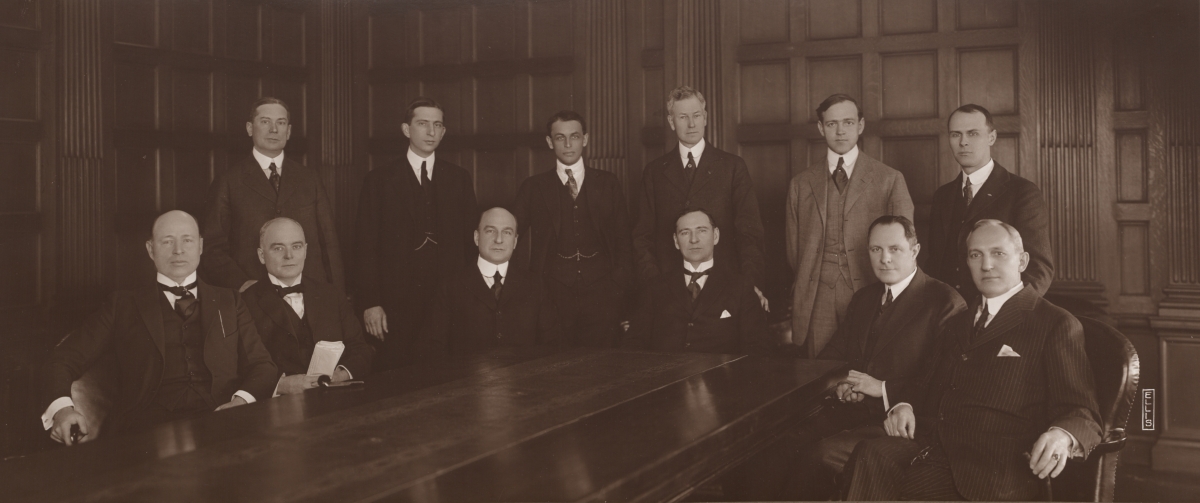The concept of return on investment (ROI) is one that is heard every day in the business world. Intuitively, the idea seems straightforward enough…if a firm wants to invest money into a project or product, then it should generate income or reduce costs that will benefit the firm over time. But how does one specifically calculate the return and, more importantly, how much of a return is enough? And if a firm has many investment options to make, how does it select the most attractive one?
These were questions that the DuPont Company grappled with as it diversified from explosives to lacquers, Pyralin plastics and dyes. Pierre S. duPont, John Raskob, Alfred I. du Pont, and T. Coleman duPont had successfully transformed it into a modern corporation with centralized business practices and financial decisions controlled by the Executive and Finance Committees. Unfortunately, a process for helping those committees to approve on new investments by linking their financial benefits to improved shareholder value still eluded them. Simply put, the formula had not been invented yet.
That was the backdrop in which a young electrical engineering graduate by the name of F. Donaldson Brown joined DuPont in 1908 as a sales rep in the Explosive Department. He had a bright mind and good instincts, which enabled him to complete his college degree at age 17. Following graduate work at Cornell, he went into electric motor sales for General Electric until his cousin, Hamilton Barksdale, helped him to get a job at DuPont selling explosives. After Barksdale became General Manager of the Explosives Department, he recruited Brown as an administrative analyst where he was exposed to a broad range of business challenges and participated in many meetings to address them. In 1914, he authored a report on the performance and accomplishments of several DuPont departments that deeply impressed Coleman duPont, the company’s president.

The DuPont Company Executive Committee in April, 1919. Donaldson Brown is standing in the light colored suit, second from right.
Coleman recommended that Brown be offered a position in the Treasurer’s Office working for John Raskob, which he accepted even though Brown had no formal training in finance. As the Assistant Treasurer in 1914, Brown developed a formula for monitoring business performance that combined earnings, working capital, and investments in plants and property into a single measure that he termed “return on investment.” It later became known in academic and financial circles as the DuPont Method (or Model) for Return on Investment. The measure was widely taught in business schools and adopted by many companies as a means of benchmarking the financial health of their products and businesses.
The DuPont Company quickly made ROI their primary performance measure for all of its operating departments. The past performance of successful businesses was used to create ROI targets for newer products and ventures. In time, an ROI forecast was required for all capital appropriations and projects submitted for approval to DuPont’s senior management.
In 1918, Donaldson Brown was promoted to Treasurer after John Raskob and Pierre duPont turned their attention to managing DuPont’s investment in General Motors. In 1921, Brown was recruited to become GM’s Vice President of Finance, where he remained until 1946. Although this required him to formally retire from DuPont, he remained on the Board of Directors and the Finance Committee. His work at GM had a sustaining impact on the application of financial disciplines and ROI concepts to other companies. During his GM tenure, he evolved his ROI concept into a pricing method for its car fleets. The idea was revolutionary. Each business or car brand established a multi-year average ROI target and a standard production volume on which to base operating costs. It then back-calculated the average fleet price that would achieve the ROI target. Alfred Sloan, GM’s legendary CEO, later wrote that this approach, coupled with fiscal disciplines brought by Brown, had been important factors in the company’s success during the 1950s.
Upon retirement from General Motors in 1946, Donaldson Brown donated many of his papers, speeches and publications to Hagley, where they are available for research in the Library and Soda House. Sloan’s book, My Life at General Motors, is also available.
In a future newsletter, we’ll discuss DuPont’s Chart Room, which was used for over fifty years by senior leadership to track the ROI and financial performance of the company’s businesses.
Gene Castellano is a contract collections specialist working on a guide to Hagley’s financial collections. He held positions in finance and business analysis at DuPont and W. L. Gore and Associates, Inc. during his professional career.
